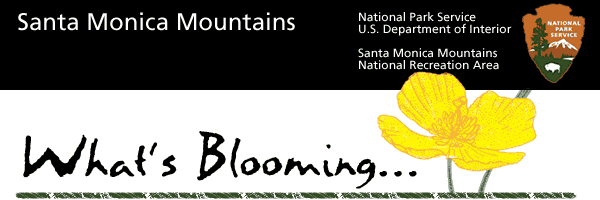
|
Available Reviews
Topanga State Park Malibu Creek State Park Circle X Ranch Zuma Canyon Wildwood Park Corral Canyon Stunt Ranch Rivas Canyon |
Date of Review
06/03 & 5/29 & 3/4 & 2/19 & 2/5. 5/29 & 5/15. 5/19. 5/11 & 12/29 & 11/27. 3/23. 3/19 & 1/1. 3/2. 1/31. |
|
| ||
|
This site performs a public service that anyone can participate in. Let us all know what you are seeing! If you are new to submitting a report (or maybe even an old hand at it) be sure and read How To Submit a Flower Report — ed. |
| Malibu Creek State Park |
|
5/26/20 |
| This is another area that burned in the Woolsey Fire. There are some fire following flowers blooming but not as many as last year. There is a lot of clarkia (farewell-to-spring, purple and elegant) and a lot of golden yarrow making for brilliant displays of hot pink and rich gold. There is also a lot of California thistle, bush mallow, woolly blue curls, white sage and some very lovely notable penstemon. Some of the adjacent hillsides are completely covered in the fire following bleeding heart poppies, but most are not. — Dorothy Steinicke | ||
| Malibu Creek State Park |
|
5/15/20 |
| I visited the Cistern Trail at the Malibu Creek State Park. They have lifted some restrictions to parking and access to Malibu Creek. Great views from the trail to the rest of the park which is covered in morning glory and dodder now. Take the trail down into the canyon and it connects to the Lookout trail. I took the left fork towards Century Lake, which is closed. You don't have to go all the way down to see a great variety of species at every turn, but not in huge numbers like last year. At the top are matilija poppies, white snapdragon, popcorn flower, purple sage, deerweed, succulent lupine, golden stars, chenactis, whispering bells, California poppy, owl's clover and red-stemmed filaree. About a third of the way down are sticky monkey flower, elegant clarkia, indian paintbrush, fringed pink, scarlet bugler, bush mallow, golden yarrow, farewell-to-spring, Catalina Mariposa lily, cliff aster, thistle, wooly blue curls, yucca, wishbone bush and caterpillar phacelia. The trailhead is marked with a small sign on Mulholland between Cornell Rd. and Las Virgenes Canyon Rd. The trail is mostly single track with some steep areas. No portapotty. — Kathy Jonokuchi | ||
| Wildwood Park (COSCA) |
|
3/23/20 |
|
In bloom: Lemonaid Berry, Chamise, Brittle Brush (aka Bush sunflower) Major bloom with 100's of millions of flowers. Wild Cucumber (man root) has set its spiny pods. Mediterranean mustard, black mustard has grown a foot in 3 days but not blooming.
Update, March 25th: Deer weed is in full color, black mustard grew another 18", purple sage has developed large buds but not open. sticky monkey flower-yellow, first blooms, soap plant first bloom, black sage developed buds but not open, everlasting pushing big buds, wishbone bush, purple nightshade, tansey mustard, a white and a yellow belly flower of some kind (very many of each). Bottom of Los Robles West: prickly phlox — Kenny Gaspar |
||
| Stunt Ranch |
|
3/2/20 |
|
We haven't had much rain in the past two months but there are still flowers coming. This trail begins along a creek and in this riparian area there are milkmaids in bloom as well as wild cucumber, purple nightshade, California bay trees and miner's lettuce. Coming up into the meadow there are a few blue dicks and some vetch. In the chaparral there are greenback ceanothus, California everlasting, Eastwood Manzanita, fuchsia flowering gooseberry and flowering ash trees. I was most excited to see a blooming wild peony.
— Dorothy Steinicke
|
||
Contact Information:
|
Santa Monica Mountains NRA 401 West Hillcrest Drive Thousand Oaks, CA 91360 805-370-2301 www.nps.gov/samo |
If you would like to contribute a wildflower report you can e-mail the editor at: SMMWildFlowers@gmail.com |
|
What's Blooming
on the web at
www.smmflowers.org/whatsblooming
or go to
www.nps.gov/samo
click on
"Plan Your Visit" > "Things to Do" > "Look for Wildflowers"






























